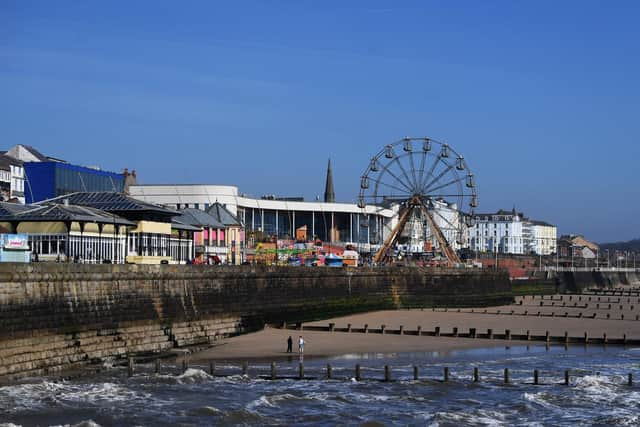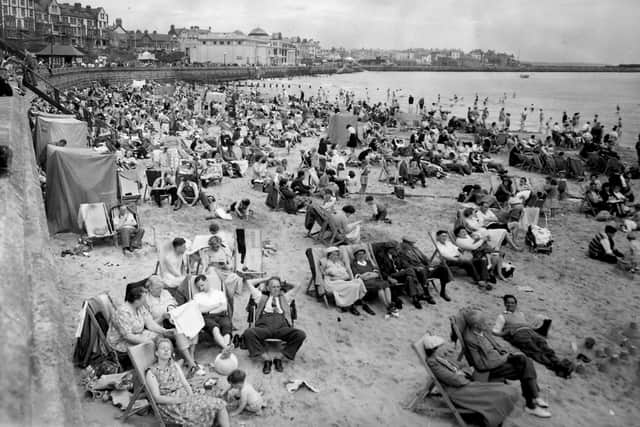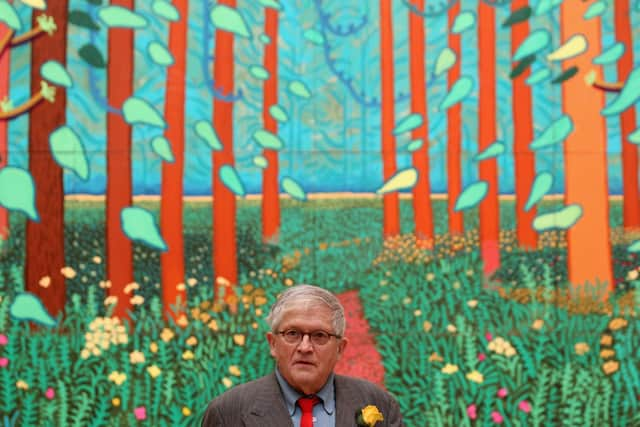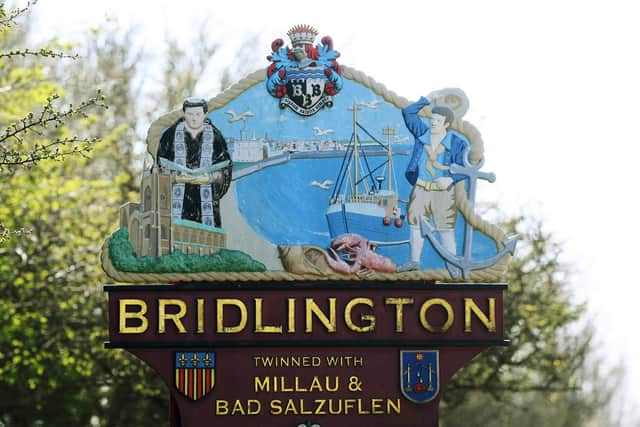Bridlington - a seaside town and lobster capital that inspired David Hockney
Carnaby Temple was built in 1770 by Sir George Strickland, the 5th Baronet of Boynton, supposedly so that he could watch his turkeys fatten and be taken into Brid to be loaded onto boats for export.
It seems that the view from the three-storey, octagonal folly is indeed impressive but how much of the rest of the story is simply an intriguing myth about an eccentric nobleman is hard to ascertain. It’s certainly true that the Strickland family introduced turkeys to Britain in the mid-16th century and that they farmed the birds in the fields and woods surrounding Carnaby and neighbouring Boynton.
Advertisement
Hide AdAdvertisement
Hide AdWhether you can supervise all this from the tower and see as far as Bridlington harbour, however, cannot be confirmed as the view is now obscured by centuries of woodland growth and the building has been bricked up and inaccessible since it was last used, as a look-out tower during the Second World War.


What the story demonstrates, though, is that before the railway made Bridlington famous as a tourist resort, the town was primarily a port for the fishing and farming industry.
The monks of Bridlington Priory exported their wool from the quay as long ago as the 12th century and, as well as products from the land or sea travelling through the town, the beaches of Brid provided raw materials for local small industry right up until the 20th century. Seaweed was gathered and taken by cart to fertilise farmers fields and the larger falls of chalk from the cliffs were turned into lime in the burners of the eponymic Lime Kiln Lane.
The two parts of the town (the original quay, which is now the harbour, and the more inland Old Town) were finally fully unified when the train station opened in 1846 and Brid changed from minor fishing port to a popular destination for day trippers attracted by the extensive beaches and the vaunted healthy waters of the chalybeate spring discovered close to where the hugely-popular Spa now stands.
Advertisement
Hide AdAdvertisement
Hide AdThe Spa itself was built in 1896 and immediately proved a draw as a dancehall and theatre. It was rebuilt after a fire in 1906 but didn’t become hugely-popular until another rebuild in 1926, when the Spa Royal Hall – with it’s impressive glass dome ceiling - was opened.


Along with the new venue came celebrated band leader Herman Darewski. Also writer of many popular songs of the day, he introduced the Darewski Dances, which resulted in the Spa turning a profit for the first time. Amazingly, some of the landladies of the town’s B&Bs started a campaign against Darewski as they objected to their lodgers arriving home from his shows after midnight. The Spa later became a concert venue and has over the years played host to everyone from Sir Cliff Richard to Oasis and Radiohead – which says much about the popularity of the venue amongst bands, promoters and audiences alike.
The other concert space to arrive during the town’s early tourist boom is the Floral Pavilion. When it was built, in 1904, summer beach concerts had become so popular that many thousands of people would congregate on the sands or promenade to enjoy them. The Floral Pavilion was built as a winter venue to ensure visitors had somewhere to see their favourite acts during the less clement months. It still stands and is these days known as the bar and café Jerome’s Pavilion.
The town’s fishing trade has changed over time as well. It was initially comparatively low key, with fishermen landing at the original wooden quay and piers to provide fish for the town and nearby parishes. The building of a permanent stone harbour in 1837 extended the trade but it wasn’t until the coming of engines, refrigeration and, particularly, trawling that it truly became a large-scale fishery.
Advertisement
Hide AdAdvertisement
Hide AdAfter decline in the 1970s, the fisherfolk of Brid reinvented themselves as crab and lobster specialists. The booming shellfish fishery has resulted in Bridlington being considered the lobster capital of Europe, worth millions of pounds to the local economy and providing a welcome view of traditional industry right in the heart of the town.


We should know as much about the ancient history of Bridlington as we do any other town in the country but coastal erosion, an inconvenient feature along Yorkshire’s coastline, means that much evidence of ancient settlements is now located in the North Sea. What can be pieced together is that there were almost certainly Bronze Age and Roman settlements.
The best proof of the presence of the Romans is the Woldgate road, which runs for ten miles inland from the west of the town and lies on top of a roman road that can be traced all the way to York.
As well as providing evidence of ancient settlement, Woldgate also inspired the most popular exhibition in the 250-year history of London’s Royal Academy.
Advertisement
Hide AdAdvertisement
Hide AdA Bigger Picture reaffirmed David Hockney as the pre-eminent artist of the age and the exhibit, which filled the main galleries of the Royal Academy in 2012, was predominantly based on images created by Hockney in Woldgate and his nearby studios.


The Bradford-born artist visited Brid many times in his youth and began painting landscapes around East Yorkshire in the 90s, when staying at his mother’s house a few feet from the beach on the south side of the town. After her death, Hockney and his assistants moved into the house and the work he completed there peaked with the RA exhibition.
A Bigger Picture contained large-scale paintings as well as watercolours and video installations illustrating the subtle effect of changing seasons on the agricultural landscapes around Bridlington. Around 750,000 people visited the Royal Academy to see the exhibition which then toured the world, making images of Bridlington familiar to many people, and Hockney fans still arrive in the town each year to seek out the locations they recognise from gallery walls.
Tourism was given another unexpected boost in recent years after the Old Town was selected to represent Walmington-on-Sea in the star-studded 2016 film of Dad’s Army. C
Advertisement
Hide AdAdvertisement
Hide Adelebrated actors such as Sir Michael Gambon, Catherine Zeta-Jones and Sir Tom Courtenay also shot scenes at nearby Flamborough and Sewerby, but it is the Old Town that’s still festooned with vintage signage and props used to enhance the unspoilt atmosphere of the town.
Editor’s note: first and foremost - and rarely have I written down these words with more sincerity - I hope this finds you well.
Almost certainly you are here because you value the quality and the integrity of the journalism produced by The Yorkshire Post’s journalists - almost all of which live alongside you in Yorkshire, spending the wages they earn with Yorkshire businesses - who last year took this title to the industry watchdog’s Most Trusted Newspaper in Britain accolade.
And that is why I must make an urgent request of you: as advertising revenue declines, your support becomes evermore crucial to the maintenance of the journalistic standards expected of The Yorkshire Post. If you can, safely, please buy a paper or take up a subscription. We want to continue to make you proud of Yorkshire’s National Newspaper but we are going to need your help.
Advertisement
Hide AdAdvertisement
Hide AdPostal subscription copies can be ordered by calling 0330 4030066 or by emailing [email protected]. Vouchers, to be exchanged at retail sales outlets - our newsagents need you, too - can be subscribed to by contacting subscriptions on 0330 1235950 or by visiting www.localsubsplus.co.uk where you should select The Yorkshire Post from the list of titles available.
If you want to help right now, download our tablet app from the App / Play Stores. Every contribution you make helps to provide this county with the best regional journalism in the country.
Sincerely. Thank you.
James Mitchinson
Editor
Comment Guidelines
National World encourages reader discussion on our stories. User feedback, insights and back-and-forth exchanges add a rich layer of context to reporting. Please review our Community Guidelines before commenting.